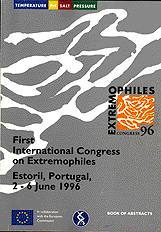Strategies for the Design of Genetic Tools in Pyrococcus
Yvan Zivanovic*, Stéphanie Marsin*, Nadia Benbouzid-Rollet*�,
Daniel Prieur� and Patrick Forterre
*Institut de génétique et Microbiologie, Université Paris-Sud, 91405 Orsay Cedex, France.
�Station Biologique de Roscoff, BP74, 29682 Roscoff Cedex, France
The present lack of cloning and expression vectors for Thermococcales and hyperthermophiles in general is a serious impediment for the rapid development of basic and applied research for these organisms. However, several different approaches are now extensively explored in this view in our laboratory and others. Various self-replicating elements have been recently isolated from hyperthermophilic archae: among them, small cryptic plasmids, virus and mobile introns, all isolated from hyperthermophiles, are good candidates as first generation replicons suitable for the construction of a cloning vector.
We decided to start working with pGT5, a small 3.5 kb plasmid isolated from Pyrococcus abyssi, which has been fully sequenced and characterised. It's sequence revealed that the plasmid is replicating via a rolling-circle type mechanism, and identification of the main sequences involved in it's replication allowed us to select potentially favourable sites for insertion of heterologous DNA sequences. This is the first step in the design of a shuttle cloning vector between Pyrococcus and E. coli, the backbone been constituted by merging pGT5 with Litmus 38, a pUC series derived plasmid from E. coli. This type of construction has been tested with various transformation protocols in order to determine the survival rate and DNA penetration efficiency in Pyrococcus cells. We have thus determined that electroporation and spheroplasts formation with PEG/EDTA are the best candidates for Pyrococcus transformation. However this type of construction offered no possibility for plasmid selection, as no functional genetic marker is carried by the vector.
The availability of a genetic marker is mandatory for the set-up of an efficient cloning vector. In this regard, our choice of phenotypic and/or resistance marker genes is scarce at present, but we had recently the opportunity to clone the purA gene from a Thermococcales in our laboratory. This gene is coding for adenylosuccinate synthetase, an enzyme which catalyses the first committed step in the de novo synthesis of AMP from IMP. The genetic background of this metabolic pathway is well-known in E. coli and selectable phenotypes are already known for several mutants of the pathway. We have checked the situation in Pyrococcus and found it nearly identical to that of E. coli with respect to purine supplements in the culture media. In particular, all strains of Pyrococcus tested for growth in presence of the adenine analogue 6-Methylpurine (6MeP) have shown to be very efficiently inhibited, as is the case for E. coli. We have thus been able to isolate on solid media a spontaneous mutant of P. abyssi strain GE5 resistant to 6MeP in presence of hypoxanthine, which should presumably be a purA mutant. PurA genes from wild type and mutant GE5 strains have been cloned and are under way of sequencing, which will eventually reveal the nature of the mutation. The mutated purA gene is thus potentially a selectable genetic marker.
The next step in the construction of a vector for hyperthermophiles consisted in the introduction of the purA gene into the hybrid pGT5/Litmus plasmid and testing for the effectiveness of the gene as a resistance marker in Pyrococcus on selective media. However, preliminary results indicated that no positive selection occurred, and a closer examination of the rescued plasmids, after several hours of cell growth following transformation, showed that heavy recombination take place presumably within Pyrococcus resulting in total loss of the purA gene. These results are anyhow encouraging as in most of the transformation attempts significant amounts of plasmid can be recovered for as long as 48 hours of continuous culture of Pyrococcus after transformation.
In summary, major improvements in several areas of the transformation protocol need to be made before the vector system can be workable. Some of them are under investigation in the laboratory: these include use of other Thermococcales-specific replicons (several new and unrelated plasmids from Pyrococcus have been recently isolated and partially characterised in our laboratory); finding more appropriate insertion sites to improve stability of the plasmids after transformation, as well as modifying the methylation pattern of the recombinant sequence to overcome a potential restriction-modification system in Pyrococcus.
|
















